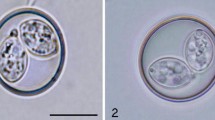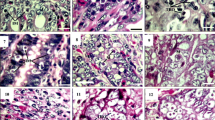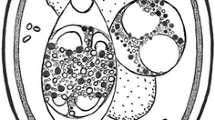Summary
A new Eimeria species—E. contorta n. sp.—is isolated from a laboratory colony of rats (Rattus norvegicus). E. contorta can be transmitted to mice (Mus musculus) and multimammate rats (Mastomys natalensis). E. contorta n. sp. is described as follows: The oocysts measure 18–27 by 15–21 μ (mean 21.4 × 16.6) the length with ratio averages 1.29. The oocysts wall is smooth and colorless. There are one to three polar granules. Micropyle, polar cap and a oocyst residual body are absent. In the sporocyst the residual body is well developed. The small stiedae bodies can be well detected when the oocysts are treated with NaOCl. The sporulation time ranges from one to three days depending on the time after infection, when oocysts were excreted. The normal number of schizogonic generations occuring is two, but sometimes it may be three. There are two types of schizonts, one containing 20 to 30 long, thin merozoites and the other 25 to 40 short, thick merozoites. The merozoites are more or less twisted within the schizonts. Gametocytes develop at the 4th to 7th day after infection; the prepatentperiod lasts 6 to 9 days. Principally, development is possible in the epithelium of the entire intestine. It usually takes place in the upper or middle small intestine or—in some specimens—it may proceed predominantly in the caecum and colon. Infections give rise to a considerable loss of weight and sometimes—mainly in rats—to death.
Zusammenfassung
Eimeria contorta n. sp. wurde aus Ratten (Rattus norvegicus) einer Laborzucht isoliert. Außer in der Ratte vermag sich E. contorta in der Maus (Mus musculus) und in Mastomys natalensis zu entwickeln. Der spezifische Wirt ist die Ratte.
Kurzbeschreibung. Die Oocysten messen 18–27 × 15–21 μ (Mittelwert 21,4 × 16,6 μ) und haben einen durchschnittlichen Index (Länge: Breite) von 1,29. Die Oocystenschale ist glatt und farblos. Es sind 1–3 Polargranula vorhanden. Mikropyle, Polarkappe und Oocystenrestkörper fehlen. Die Sporocystenrestkörper sind groß. Die kleinen Stiedaekörper sind vor allem nach Behandlung der Oocysten mit NaOCl zu erkennen. Die Sporulationsdauer beträgt 1–3 Tage. E. contorta durchläuft 2, seltener 3 Schizogoniegenerationen. Es lassen sich 2 Typen von Schizonten unterscheiden: solche mit 20–30 langen, dünnen und solche mit 25–40 kurzen, dicken Merozoiten. Die Merozoiten sind innerhalb der Schizonten mehr oder weniger stark ineinander verdreht. Gametocyten finden sich ab 4.–7. Tag nach der Infektion. Die Praepatenzzeit beträgt 6–9 Tage. Die Entwicklung ist im gesamten Darmtrakt möglich, sie erfolgt bevorzugt im oberen bis mittleren Dünndarm oder Caecum und im Colon. E. contorta führt zu Gewichtsverlust bei relativ geringer Letalität.
Similar content being viewed by others
Literatur
Becker, E. R.: Infection with a single coccidian oocyst and its significance. Amer. Naturalist 68, 571–574 (1934).
Dieben, C. P. A.: Über die Morphologie und Biologie des Ratten-Coccidium Eimeria nieschulzi n.sp. und dessen Verteilung in Holland. [Holländ.] Proefschrift. Veeartsenijk. Hoogeschool Utrecht (1924).
Haberkorn, A.: Zur Empfänglichkeit nicht spezifischer Wirte für Schizogonie-Stadien verschiedener Eimeria-Arten. Z. Parasitenk. 35, 156–161 (1970).
Hammond, D. M., Andersen, F. L., Miner, M. L.: The occurence of a second. asexual generation in the life cycle of Eimeria bovis in calves. J. Parasit. 49, 428–434 (1963).
Levine, N. D.: Coccidiosis. Ann. Rev. Microbiol. 17, 179–198 (1963).
Ivens, V.: The coccidian parasites (Protozoa, Sporozoa) of rodents, p. 118 ff. Urbana: The University of Illinois Press 1965.
Marquardt, W. C.: Attempted transmission of the rat coccidium Eimeria nieschulzi to mice. J. Parasit. 52, 691–694 (1966).
Mudrow, L., Reichenow, E.: Endotheliale und erythrocytäre Entwicklung von Plasmodium praecox. Arch. Protistenk. 97, 101–170 (1944).
Pellerdy, L. P.: Katalog Eimeriidea. Budapest: Akadémiai Kiadó 1963.
Katalog Eimeriidea, Suppl. I. Budapest: Akadémiai Kiadó 1969.
Pérard, C.: Sur la coccidiose du rat. Rec. Med. Vet. Bull. Mem. Soc. Centr. Med. Vet. 102, 120–124 (1926).
Reichenow, E.: Die Hämococcidien der Eidechsen. Vorbemerkungen und I. Teil: Die Entwicklungsgeschichte von Karyolysus. Arch. Protistenk. 42, 179–291 (1921).
Scholtyseck, E.: Die Mikrogametenentwicklung von Eimeria perforans. Z. Zellforsch. 66, 625–642 (1965).
Schrecke, W.: Experimentelle Coccidieninfektionen bei neugeborenen Tieren. Dissertation Vet. med. Fakultät Giessen (1969).
Dürr, U.: Excystations- und Infektionsversuche mit Kokzidienoocysten bei neugeborenen Tieren. Zbl. Bakt., I. Abt. Orig. 215, 252–258 (1970).
Todd, K. S., Hammond, D. M.: Life cycle and host specifity of Eimeria callospermophili Henry, 1932, from Uinta ground squirrel Spermophilus armatus. J. Protozool. 15, 1–8 (1968).
Life cycle and host specifity of Eimeria larimerensis Vetterling, 1964, from the Uinta ground squirrel Spermophilus armatus. J. Protozool. 15, 268–275 (1968).
Wagner, W. H., Foerster, O.: Die PAS-AO-Methode, eine Spezialfärbung für Coccidien im Gewebe. Z. Parasitenk. 25, 28–48 (1964).
Yakimoff, W. L., Gousseff, W. F.: Die Coccidien der schwarzen Ratte. Z. Parasitenk. 8, 505–508 (1936).
Author information
Authors and Affiliations
Additional information
Herrn Prof. Dr. R. Gönnert zum 60. Geburtstag gewidmet.
Rights and permissions
About this article
Cite this article
Haberkorn, A. Zur Wirtsspezifität von Eimeria contorta n. sp. (Sporozoa: Eimeriidae). Z. F. Parasitenkunde 37, 303–314 (1971). https://doi.org/10.1007/BF00259336
Received:
Issue Date:
DOI: https://doi.org/10.1007/BF00259336




